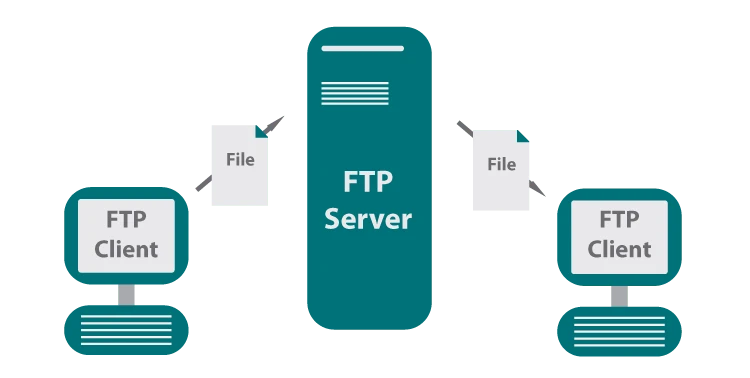As businesses become more reliant on technology, secure file transfer protocols become increasingly important. FTPS (File Transfer Protocol Secure) is a secure file transfer protocol that provides authentication and encryption to protect data as it travels between two systems. This protocol is used by businesses to securely connect with their customers, trading partners, and users.
What Is FTPS?
FTPS is an extension of the File Transfer Protocol (FTP). It adds an additional security layer, allowing files to be transferred over a secure connection. The added security ensures that files are protected from interception or tampering as they travel between two systems. FTPS also supports authentication via client certificates and server identities, making it easier for businesses to ensure that only authorized users can access their data.
How Does It Work?
FTPS uses the same port for both communication and data transfer. This makes it simpler to set up firewall rules since all traffic is routed through one port. Additionally, FTPS authenticates both the server and the client using SSL/TLS protocols before any data is exchanged. Data is then encrypted using a symmetric cipher and transmitted securely between systems. As an added layer of security, FTPS also allows for integrity verification of the transferred files via digital signatures or checksums.
Benefits of Using an FTPS Server
There are several benefits associated with using an FTP server:
• Increased Security: The added encryption and authentication layers provided by the FTPS protocol help protect your files from interception or tampering while in transit. Additionally, integrity verification ensures that your files remain intact throughout their journey across networks.
• Easier Firewall Configuration: Since all traffic is routed through one port, setting up firewall rules becomes simpler than with other file transfer protocols such as SFTP or FTP over SSH tunnels. This makes it easier to ensure network security without needing complex configurations or additional software solutions.
• Faster File Transfers: With its single connection setup, FTPS allows for faster file transfers than other protocols such as SFTP which need multiple connections in order to function properly.
How To Set Up An FTPS Server
Setting up an FTPS server requires installing a web server such as IIS (Internet Information Services). Once IIS has been installed on the system, you will need to add the FTP Server role service in order to enable the FTP protocol on your system. After this step has been completed you will then need to configure your firewall settings in order to allow incoming traffic on port 21 (the default port used by FTP). Once these steps have been completed you will be ready to use your new FTPS server!
FTPS offers increased security and easier configuration than other file transfer protocols such as SFTP or FTP over SSH tunnels while allowing for faster file transfers due to its single-connection setup. If your business requires secure file transfers across networks then setting up an FTPS server may be the right solution for you!

Setting Up an FTP Server
Setting up an FTPS server involves several steps. First, you will need to install the necessary software, such as an FTP server and a web server like IIS. Once these have been installed, you can then configure the FTP server to use FTPS. This can involve setting up certificates and encryption methods. You may also need to modify some settings in your firewall or router to allow external access. Finally, you will need to configure user accounts that are allowed to access the FTP server, and any other security measures you wish to take. After all of these steps have been completed, your FTPS server should be ready for use!
The Difference Between SFTP and FTPS
Yes, there is a difference between SFTP and FTPS. SFTP stands for Secure File Transfer Protocol and builds upon the Secure Shell (SSH) protocol. It provides secure file transfers over an encrypted connection and allows for multiple file operations such as directory listings, file uploads, downloads, deletions, and more.
FTPS stands for File Transfer Protocol over SSL/TLS and is an extension of the original FTP protocol. It provides an encrypted connection using the TLS/SSL tunneling protocol to protect data in transit over the network. The FTPS protocol uses only one port, making it easier to install firewall solutions as compared to SFTP which requires multiple ports to be opened on the firewall. FTPS also supports client authentication that can be used to authenticate users before any data transfer takes place.
Is FTPS Still Relevant?
Yes, FTPS (File Transfer Protocol Secure) is still widely used today. It is an extension of the original FTP protocol that adds support for TLS/SSL, which provides secure authentication and encryption of data in transit. FTPS is a secure alternative to the standard FTP protocol and has become a popular choice for organizations looking to protect their file transfers from malicious attacks. It also allows users to bypass firewalls more easily, as it employs port 21 (the standard FTP port) instead of requiring a separate port like FTPS and SFTP. Overall, FTPS provides a secure solution for transferring sensitive files between two systems.
Accessing an FTP Server
To access your FTPS server, first, open a file explorer and type ftp:// followed by the IP address of the server. You will then be prompted to enter your username and password. These credentials are usually Windows or Active Directory credentials. Once you have logged in, you will be able to see all the files and folders on the server. If you need assistance with setting up or accessing your FTPS server, please do not hesitate to contact your administrator for help.
Transferring Files Using FTPS
To transfer files using FTPS, you’ll need to first locate the target deployment and log into the Control Panel. Once you’re in, locate your target deployment on either the Home page or the My Applications page.
Next, go to the FTPS page and get all of the necessary FTP information you’ll need, such as hostnames, ports, and user credentials.
Once you have all that information, you can use an FTP client like FileZilla to connect to your FTP server and begin transferring data into it. To do this, open FileZilla and enter your login credentials – including your username and password – into the fields provided. Then press ‘Quickconnect’ to establish a connection with the FTP server.
Now that you’re connected, simply drag and drop your files from your local computer into the remote directory on the server. You can also create new directories using FileZilla’s interface if needed. When finished transferring files, simply click ‘Disconnect’ to end your connection with the FTP server.
Protocol Used by FTPS
FTPS (File Transfer Protocol over SSL/TLS) is an extension of the standard File Transfer Protocol (FTP) that adds support for the Transport Layer Security (TLS) and the Secure Sockets Layer (SSL) cryptographic protocols. It works by establishing an encrypted connection between a server and a client using one of these two protocols. This connection allows for secure data transfer between the two machines, ensuring that only authorized users can access sensitive information. TLS is the most widely used protocol for securing FTP transfers, though FTPS also supports SSL.
The Protocol Used by FileZilla
FileZilla supports both SFTP and FTPS, making it a versatile choice for secure file transfers. SFTP is an SSH file transfer protocol, while FTPS is an extension of the standard File Transfer Protocol (FTP) that uses SSL/TLS encryption to keep data secure. Both protocols provide strong authentication and encryption methods to protect users’ data during file transfers. With FileZilla, users can securely transfer files between two computers over the internet, ensuring that all data is kept safe from third-party interception.
The Benefits of Using FTPS Over FTP
FTPS is better than FTP because it provides an additional layer of security. It uses SSL/TLS encryption to protect data during transmission, which means that the information sent between a client and a server remains secure. Additionally, FTPS can authenticate the server using a digital certificate and can also authenticate the client using its own credentials. This is not possible with plain FTP. Additionally, FTPS allows for more control over user access, as well as encryption of both commands and data transfers, providing an extra layer of protection for sensitive data.
Does Windows Have an FTPS Client?
Yes, Windows does have an FTPS client. WinSCP is a popular and free SFTP and FTP client for Windows that supports FTPS (FTP over SSL/TLS). With WinSCP you can securely transfer files between your local computer and a remote server using the FTP, FTPS, SCP, SFTP, WebDAV, or S3 file transfer protocols. It also provides a secure file manager to browse the files on the remote server. Additionally, you can use WinSCP to synchronize directories, edit files remotely and even create scripts to automate tasks.
The Security of FTPS
Yes, FTPS is a secure protocol that provides an encrypted connection for transferring files between two computers. It uses strong encryption algorithms such as AES and Triple DES to protect key file transfers from unauthorized access or manipulation. Additionally, FTPS supports authentication methods that allow only authenticated users to access the FTP server. By using FTPS, you can ensure your data remains safe and secure during transmission.
Conclusion
In conclusion, FTPS is a secure file transfer protocol that provides businesses with a reliable and secure way to exchange files with their trading partners, customers, and users. It builds on the File Transfer Protocol (FTP) by providing an additional layer of security and encryption, making it easier to install firewall solutions. FTPS is easy to install and use, making it an ideal choice for businesses looking for a safe and secure way to exchange files.








